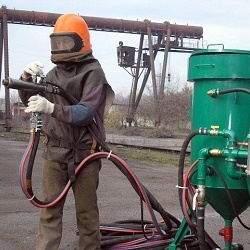How to increase the water pressure in the apartment and private house
A good, high-quality water supply is a guarantee of not only the normal operation of numerous household appliances, but also a high level of comfort. Unfortunately, in many cases, the recommended parameters of fluid pressure in the system are not observed. It is not only about private houses with their own wells, but also apartments in high-rise buildings. Properly selected and installed pump to increase the water pressure will get rid of many annoying troubles and achieve the desired level of comfort.
Content
Water pressure in a private house and apartment
Household appliances first reacts to a decrease in water pressure in the apartment. This may manifest itself in the form of some cases:
- washing machine refuses to carry out the program, to draw water;
- dishwashing plants poorly perform their functions or refuse to start;
- boilers for hot water work in the “stop-stop” mode or signal the lack of pressure in the system;
- electric heating boilers with insulated tank are not able to supply hot water due to the lack of its receipt.
These signs are a clear indication that there is not enough pressure in the plumbing system in an apartment building.
Important! This can occur not only due to reduced feed characteristics. On the upper floors, a drop in pressure is observed due to insufficient volume of incoming fluid. In essence, lower-level apartment dwellers, taking water, affect the pipeline indicators of the neighbors from above.
The normalized pressure in the water supply network is from 0.3 to 6 bar (atmospheres). But do not assume that the indicator at 0.3 atm is the norm. In practice, most household appliances are designed for stable operation at pressures from 1.2 to 2 bar, and exceeding a maximum of 6 can cause breakdowns.It is these indicators that should be maintained in the intra-distribution network.
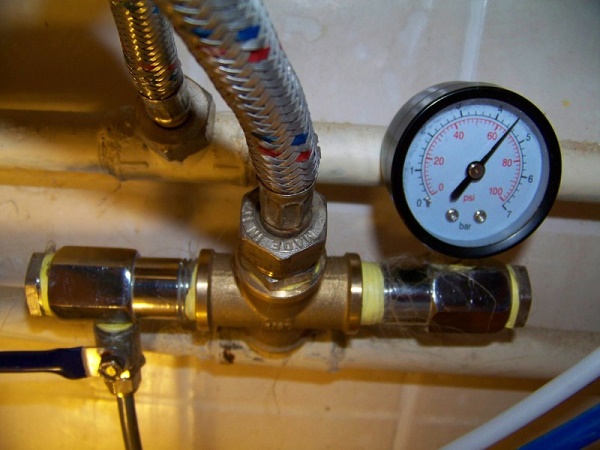
In multi-storey private houseswhere a high pressure pump is used for delivery from a well, a figure of 10 bar or more can be achieved in pipes. In this case, the engineering network is built on welded joints, limiters are installed at the right points. Planning the structure of pipelines for water in a private house should be careful to avoid emergency situations.
Water pressure measurement
Knowing how to determine a specific pressure value in a water supply system is useful in a number of cases. For example, if the plans include the purchase of a sophisticated high-tech household appliance, whose electronic systems block work with inappropriate parameters of the resource consumed. There are several ways to measure the pressure in the water supply network.
- Buy special pressure gauge - the most preferred way. Completion of devices from individual manufacturers includes adapters. With their help, the device can be connected even by screwing it into the outlet of the crane gander, which is convenient for measuring pressure at a specific point in an apartment or house.
- Those who for some reason cannot buy or rent a pressure gauge will easily do plastic bottle measuring device5 l. Its shell will withstand a dynamic pressure surge of at least 5 bar.
The principle of the homemade device simple as graduation. A thin plastic tube leading to a screw-in flange is drawn through the plug. Measures are being taken to seal all connections. The resulting system is installed at the control point, water is running in the water supply. When filling the bottle, the air creates back pressure. Graduation system - linear arithmetic. When filling a bottle that is installed vertically upside down, the pressure is half a bar at 1 bar. Three-quarters - 2 bars. 85% - 4 atmospheres and so on.
Ways to increase the pressure in the apartment and private house
However, if the whole structure is a modern metal-plastic, you need to move to more radical measures. Today, the industry offers water pumps for home plumbing. They are compact and can easily solve the problem of low pressure.However, for leveling under-supply, it is recommended to install cumulative station, which is the most convenient solution for water supply of a private house.
A simple pressure stabilization scheme looks like this. At the entrance to the apartment is set to increase the pressure pump. With a small length of pipes inside the premises of this tool will be enough for a private house. If there are a lot of consumers in the water distribution network, it is recommended to install a booster pump at critical points. This may be a bathroom with Jacuzzi bath or laundry with washing machine.

When an insufficient amount of liquid is supplied to an apartment on the upper floor, it is recommended to allocate a place for a stabilizing station. Water supply with storage tank and pump works on the following principle:
- water is fed into the tank from the entrance to the apartment;
- the set in the tank is controlled by a pressure sensor or a mechanical system of a float and a shut-off valve;
- when you open the tap for water supply inside the apartment, a low pressure pump starts working, which takes the liquid from the tank.
The system of the accumulation-compensatory station helps not only to level the insufficient supply of liquid to the apartment, but also is capable of helping out much when there is no supply in the central water supply system. The taps will be supplied with water previously collected in the tank. Such a scheme works well in a small private house, where the liquid flows from a deep well in an amount insufficient for normal consumption.
For those who do not wish to design the system themselves, the industry offers a whole range of ready-made solutions. Scheme plumbing with submersible pump and hydroaccumulator compact, works on the same principle of accumulation and stabilization. The supercharger carried out and located in the well supplies water to a tank equipped with a pressure sensor. When water is taken off, the pump starts simultaneously and the liquid is pumped from the storage tank. This allows the pressure to fall more slowly and provide a large selection. The scheme can be supplemented by a pump for pumping, the task of which is to form a flow with a precisely expressed parametric.

In multi-storey buildings, an additional lifting unit is installed to reduce the cost of a system for raising water from a well.Its task is to supply one or several floors with water with standardized pressure.
Types of pumps to increase water pressure
When choosing a specific unit for raising the water pressure, it is worth carefully analyzing the future operating conditions of the pump. From them will depend on the most successful choice of model. Among the important factors:
- the possibility of contact with the air supply;
- control system, the ability to integrate with external sensors or command nodes;
- sensitivity to mechanical impurities in water.
The pump must be selected for performance, placement conditions. It will not be superfluous to analyze response patterns to events. Automatic pumps able to switch off independently in potentially dangerous situations, maintain stabilized pressure.
Wet Rotor Centrifugal Pumps have a clear limitation of use: the ingress of air into the supply nozzle can be dangerous. The devices are highly productive, the system as a whole consists of an engine and a fluid transportation unit. This suggests that it is impossible to buy an extremely quiet and compact device, but the level of maintainability of wet-rotor pumps is very high.

Dry rotor centrifugal pumps indifferent to impurities in the transported liquid, the air in the pipe, can boast of increased efficiency and high performance. Their basic features are similar to wet-rotor systems.
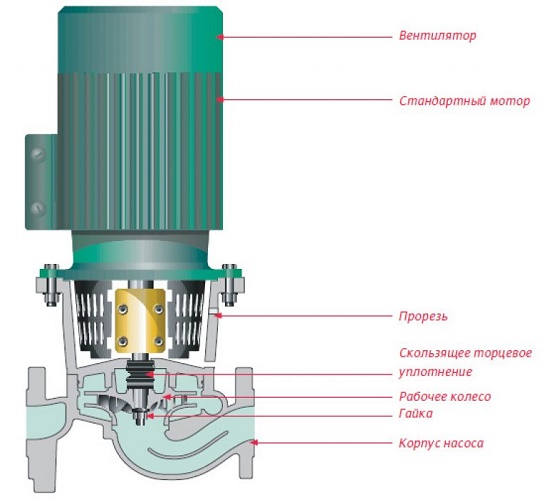
To minimize interference with the operation of the pressure boosting system, it is recommended to use self-priming pumps. This is not a separate class of devices. A feature of the centrifugal self-priming pump is the ability to independently remove air from the feed pipe. Also, models offered on the market are equipped with pressure control systems, emergency mode locking and other automatics.
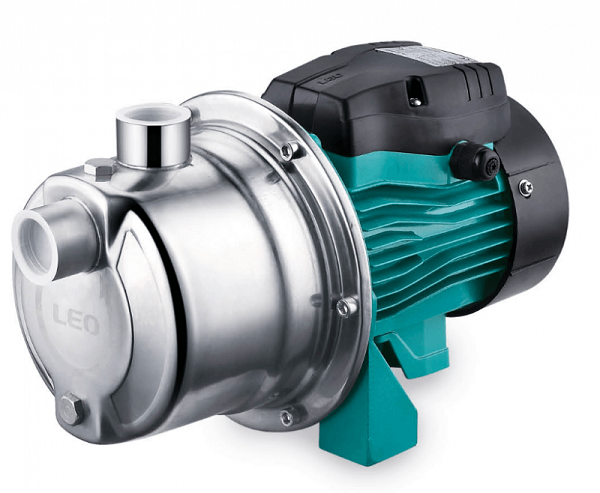
Considering the range of proposals of centrifugal pumps, you can find a model of any capacity (from 10-15 cubic meters per hour to 3500-4000) to equip both an apartment and a private house. Using devices of this class, it is easy to build a pressure unit as well as to strengthen the flow of fluid in the water supply system.
A centrifugal supercharger operating as a flow-through pump can rightly be called the average statistical solution to most of the tasks of raising the pressure of water.However, in a private house, it may be used to transport fluid from a deep well. vibratory submersible or plunger pump high pressure, and in the apartment - extremely quiet models of membrane class.
Pump control systems
Manual pump control system - a very rare occurrence. This is often a simple power switch. It can be installed directly next to the water tap to ensure proper control.
It should be understood that all manual systems enhance the so-called human factor. Using them to get an emergency mode of the pump, water leaks and other troubles is very simple, just distract and forget about the equipment turned on. Therefore, automation today is installed on most household systems, it is recommended for selection, it shows excellent results. Among the controls may be:
- the termination of work at achievement of the set pressure at the exit;
- maintaining a stable output parameter;
- network voltage control;
- dry run stop;
- termination due to external pressure sensor signal.
Automation can be like built-in pump electronics and external. The simplest case of forced control is the interruption of power upon the occurrence of a specific event. For example, a pump may regulate a hydroaccumulator by stopping when pressure is reached, or a leak sensor that detects an emergency.
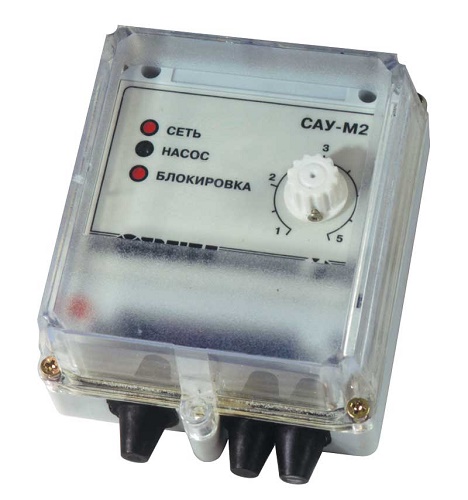
The device for control of the submersible pump ARIES SAU-M2
Parameters for pump selection
The key parameters for pump selection are the capacity in cubic meters per hour, the height of the rising water at the outlet and at the inlet. For the apartment is very important first parameter. Calculate performance is quite simple:
- determine the number of consumers;
- to summarize the average consumption (sink - 60 liters per hour, sink - 80, bathroom set - 300, shower - 115, toilet - 83, washing machine - 200 liters per hour).
Other parameters are important for a private house with a well. Height of rising water indicates the depth at which the fluid can be transported. BUT secondary column parameter is selected in accordance with the height of the house.Moreover, if a pump is bought, the height of water rise of which is not used at 100% - this does not mean that it will successfully lift the water to the third floor, if an exit column of 5 meters is indicated in the passport.
Device power selected by existing wiring in the apartment. In older buildings it is recommended to install several pressure boosting points to stabilize the load. For a private house, the task is solved more simply: any powerful power line can be brought to the pump, starting it directly from the meter.
Overall parameters The supercharger is also selected individually, focusing on the convenience of its installation in accordance with the manufacturer's recommendations for cooling and the length of the supply and exhaust lines.
Conclusion
When choosing a pump to increase the pressure is to carefully analyze all factors. For example, choose automatic control systems, determine the causes of insufficient fluid flow, explore the optimal points for equipment installation. And then among the numerous proposals of the modern industry there will definitely be an option that can get rid of all the trouble with water in an apartment or a private house.

/rating_off.png)








